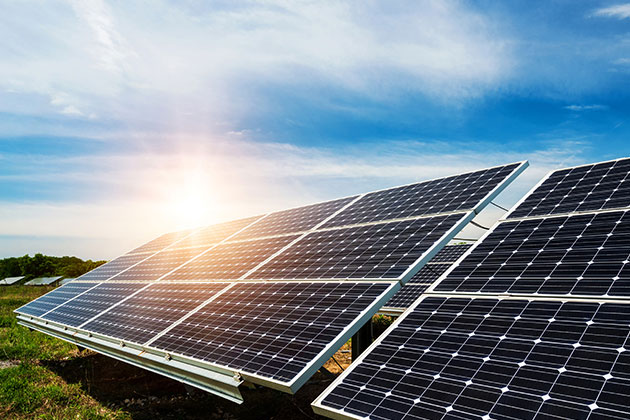Study describes a novel all-perovskite tandem ແສງຕາເວັນ cell which has the potential to provide inexpensive and more efficient way to harness Sun’s energy to generate electrical power
ການເອື່ອຍອີງຂອງພວກເຮົາກ່ຽວກັບແຫຼ່ງທີ່ບໍ່ແມ່ນທົດແທນຂອງ ພະລັງງານ ເອີ້ນວ່າ ເຊື້ອໄຟຟອດຊິນ ເຊັ່ນ: ຖ່ານຫີນ, ນ້ຳມັນ, ອາຍແກັສ ໄດ້ສົ່ງຜົນກະທົບທາງລົບຢ່າງໃຫຍ່ຫຼວງຕໍ່ມະນຸດ ແລະສິ່ງແວດລ້ອມ. ການເຜົາໄຫມ້ນໍ້າມັນເຊື້ອໄຟເພີ່ມຜົນກະທົບເຮືອນແກ້ວແລະເຮັດໃຫ້ໂລກຮ້ອນ, ທໍາລາຍທີ່ຢູ່ອາໄສ, ເຮັດໃຫ້ເກີດມົນລະພິດທາງອາກາດ, ນ້ໍາແລະດິນແລະຜົນກະທົບຕໍ່ສຸຂະພາບສາທາລະນະ. ມີຄວາມຈໍາເປັນອັນຮີບດ່ວນທີ່ຈະສ້າງເຕັກໂນໂລຢີທີ່ຍືນຍົງເຊິ່ງສາມາດຊ່ວຍໄດ້ ພະລັງງານ ໂລກໃຊ້ພະລັງງານສະອາດ. ພະລັງງານແສງຕາເວັນ technology is one such method which has the capability to harness Sun’s light – the most abundant renewable source of energy – and convert it into electrical energy or power. The advantageous factors of ແສງຕາເວັນ energy in terms of benefitting humans and environment have played a key role in promoting use of ແສງຕາເວັນ ພະລັງງານ.
ຊິລິໂຄນແມ່ນວັດສະດຸທີ່ໃຊ້ທົ່ວໄປໃນການສ້າງ ແສງຕາເວັນ ຈຸລັງໃນ ຫມູ່ຄະນະແສງຕາເວັນ that are available in the market today. The photovoltaic process of ແສງຕາເວັນ cells can transform sunlight into electricity without additional use of any fuel. Design and efficiency of silicon ແສງຕາເວັນ panels has significantly improved over decades due to advancements in manufacturing and technology. The photovoltaic efficiency of a ແສງຕາເວັນ cell is defined as the portion of the energy which is in the form of sunlight and which can be converted into electricity. Photovoltaic efficiency and overall costs are the two main limiting factors in ແສງຕາເວັນ panels today.
Apart from silicon ແສງຕາເວັນ cells, tandem ແສງຕາເວັນ cells are also available in which specific cells are used which are optimized for every section of the Sun’s spectrum thereby leading to increase in overall efficiency. A material called perovskites is considered better than silicon in absorbing high-energy blue photons from sunlight i.e. another part of the Sun’s spectrum. Perovskites are polycrystalline material (generally methylammonium lead trihalide (CH3NH3PbX3, where X is iodine, bromine or chlorine atom). Perovskites are easy to process into sunlight-absorbing layers. Earlier studies have combined silicon and perovskites into solar cells i.e. having silicon cells on the top which can absorb yellow, red and near infrared photons along with perovskite cells thus almost doubling the production of power.
ໃນການສຶກສາ ໃໝ່ ທີ່ເຜີຍແຜ່ໃນ ວິທະຍາສາດ on May 3 researchers have for the first time developed all perovskites tandem solar cells which give efficiency of up to 25 percent. This material is called lead-tin mixed low-band gap perovskite film ((FASnI3)0.6 MAPbI3)0.4; FA for formamidinium and MA for methylammonium). Tin has the disadvantage of reacting with oxygen from air creating defects in the crystalline lattice which can disrupt movement of electrical charge in the ແສງຕາເວັນ cell thereby limiting cell’s efficiency. Researchers found a way to prevent tin in perovskite from reacting with oxygen. They used a chemical compound called guanidinium thiocyanate to significantly improve structural and optoelectronic properties of lead-tin mixed low-band gap perovskite films. The compound guanidinium thiocyanate coats perovskite crystallites in the ແສງຕາເວັນ absorbing film thus preventing oxygen from going inside to react with tin. This straightaway enhances efficiency of the solar cell from 18 to 20 percent. Also, when this new material was combined with conventionally used high-absorbing top perovskite layer, the efficiency further increased to 25 percent.
ການສຶກສາໃນປັດຈຸບັນອະທິບາຍສໍາລັບການອອກແບບຄັ້ງທໍາອິດຂອງຈຸລັງແສງຕາເວັນ tandem ໂດຍໃຊ້ຮູບເງົາບາງໆ perovskite ແລະເຕັກໂນໂລຢີນີ້ສາມາດທົດແທນຊິລິໂຄນໃນຈຸລັງແສງຕາເວັນໄດ້. ວັດສະດຸໃຫມ່ມີຄຸນນະພາບສູງ, ລາຄາບໍ່ແພງແລະການຜະລິດຂອງມັນແມ່ນງ່າຍດາຍກວ່າໃນຂະນະທີ່ຄ່າໃຊ້ຈ່າຍຕ່ໍາເມື່ອທຽບກັບຊິລິໂຄນແລະຊິລິຄອນ perovskites tandem ຈຸລັງ. Perovskites ແມ່ນວັດສະດຸທີ່ສ້າງຂຶ້ນໂດຍມະນຸດເມື່ອປຽບທຽບກັບຊິລິໂຄນແລະແຜ່ນ solar ໂດຍອີງໃສ່ perovskites ແມ່ນມີຄວາມຍືດຫຍຸ່ນ, ນ້ໍາຫນັກເບົາ, ແລະເຄິ່ງໂປ່ງໃສ. ເຖິງແມ່ນວ່າອຸປະກອນການໃນປະຈຸບັນຈະໃຊ້ເວລາໄລຍະຫນຶ່ງເພື່ອລື່ນປະສິດທິພາບຂອງເຕັກໂນໂລຊີ silicon-perovskite. ຢ່າງໃດກໍຕາມ, ຮູບເງົາ polycrystalline ທີ່ອີງໃສ່ perovskite ມີທ່າແຮງສໍາລັບການອອກແບບຈຸລັງແສງຕາເວັນ tandem ເຊິ່ງສາມາດສະຫນອງປະສິດທິພາບໄດ້ເຖິງ 30 ເປີເຊັນໃນຂະນະທີ່ຮັກສາປັດໃຈອື່ນໆທີ່ບໍ່ມີການຂັດຂວາງ. ການສຶກສາເພີ່ມເຕີມແມ່ນມີຄວາມຈໍາເປັນເພື່ອເຮັດໃຫ້ວັດສະດຸແຂງແຮງ, ມີຄວາມຫມັ້ນຄົງຫຼາຍແລະຍັງສາມາດນໍາມາໃຊ້ໃຫມ່ເພື່ອຫຼຸດຜ່ອນຜົນກະທົບຕໍ່ສິ່ງແວດລ້ອມ. ຂະແຫນງພະລັງງານແສງຕາເວັນແມ່ນຫນຶ່ງໃນການຂະຫຍາຍຕົວໄວທີ່ສຸດແລະເປົ້າຫມາຍສຸດທ້າຍແມ່ນເພື່ອຄົ້ນພົບທາງເລືອກທີ່ດີສໍາລັບພະລັງງານສະອາດ.
***
{ທ່ານສາມາດອ່ານເອກະສານການຄົ້ນຄວ້າຕົ້ນສະບັບໄດ້ໂດຍການຄລິກທີ່ລິ້ງ DOI ທີ່ໃຫ້ໄວ້ຂ້າງລຸ່ມນີ້ໃນລາຍຊື່ແຫຼ່ງທີ່ອ້າງອີງ}
ແຫຼ່ງຂໍ້ມູນ (s)
Tong J. et al. 2019 ອາຍຸການໃຊ້ງານຂອງຜູ້ໃຫ້ບໍລິການ > 1 μs ໃນ Sn-Pb perovskites ເຮັດໃຫ້ເຊລແສງຕາເວັນທີ່ມີປະສິດຕິພາບທັງໝົດ perovskite tandem. ວິທະຍາສາດ, 364 (6439). https://doi.org/10.1126/science.aav7911






































